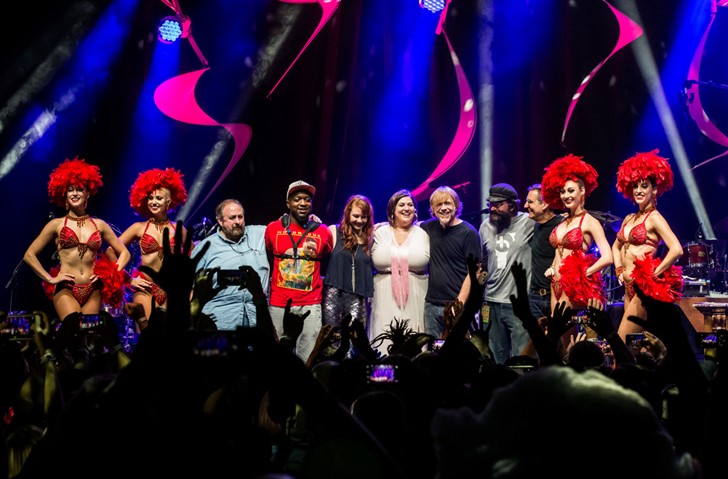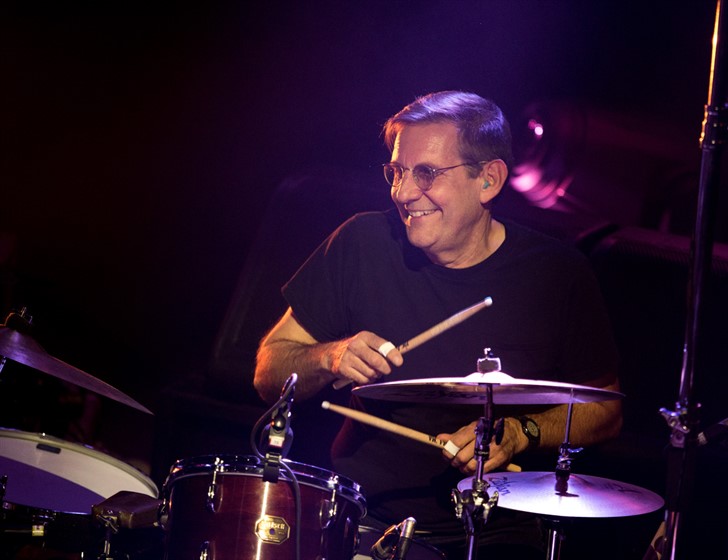Rise/Come Together: Russ Lawton on 20 years of TAB
 Erik Kabik
Erik Kabik
On the 20-year anniversary of the first time the trio of musicians that would become the original Trey Anastasio Band lineup shared the stage, we offer some thoughts from drummer Russ Lawton, who first played with Anastasio as part of 8 Foot Fluorescent Tubes and has remained a core member of TAB for most of the group’s two-decade run. He also performs with TAB keyboardist Ray Paczkowski in Soule Monde. Anastasio, Lawton and bassist Tony Markellis will open their first TAB Trio tour since 1999 tonight in Cleveland.
On April 17, 1998, 8 Foot Fluorescent Tubes played its first (and only) show at Higher Ground in Winooski, Vt. For the night, Trey Anastasio brought in several local musicians, including Tony Markellis and I, marking the beginning of what would become Trey Anastasio Band (TAB).
I had first met Tony years before—in 1977—when I was playing a weekly residency with the Afro-Funk band Zzebra in Burlington, and he was playing around the area with The Unknown Blues Band and Kilimanjaro. I was outside on break with Zzebra, and Tony introduced himself and said that he enjoyed the band and my playing.
At that time, I was living in Woodstock, N.Y., taking workshops at Creative Music Studio, checking out great musicians—stuff with drummers Steve Gadd and Chris Parker, session-great bassist Harvey Brooks and jazz drummer Roy Haynes at the club The Joyous Lake. Within a short amount of time, Zzebra’s schedule was filling up and it became obvious that I needed to make the full-time move to Burlington for the band.
About five years later, Trey visited Burlington to check out UVM. As he’s said before, he decided on UVM after he was knocked out by Tony’s playing with The Unknown Blues Band. I didn’t meet Trey until 1998, but I’d seen Phish at Nectar’s, and I would hear their songs on the radio in Boston and really enjoyed their music. The funny thing is, I lived at 204 Pine Street in Burlington and was moving to Boston with the band Little Sister to be part of the thriving original music scene. Coincidentally, Trey was moving into the connecting apartment at 202 1/2 Pine Street. I often think that if I had stayed in town, then we would have possibly played together sooner.
Even when I was living in Boston, Tony and I kept in touch. He even asked me to join The Unknown Blues Band a couple of times. So, when Trey contacted Tony to put a band together to play a show for Higher Ground’s opening, he asked Tony for some drummer suggestions, and Tony gave him my name.
 Erik Kabik
Erik Kabik
My first meeting with Trey was when he, Tony and I got together in Vermont. Trey made me feel right at home. Instead of just working on his new songs, he asked me for some grooves and suggested something since it had a “ fifth-gear feel to it,” so I gave him the “First Tube” beat. It gelled right from the first bar, and it felt so great. A week later, when I got a tape to learn the finished songs that he wrote from the jams, I knew that the Higher Ground show was going to be a special night.
In 1999, we did our first official tour as a trio, playing songs from the Higher Ground show, like “Sand,” “First Tube” and “Mozambique,” as well as some of Trey’s new ones like “Windora Bug,” “Heavy Things,” and choice covers of “O-o-h Child” and “Will It Go Round in Circles?” I grew up playing in that trio setting and it felt very comfortable to me. It was a wonderful progression. We’ve introduced a lot of great songs since then, including “Push on ‘Til the Day,” “Drifting,” “Pigtail” and “Greyhound Rising,” just to name a few.
Along the way, Trey added a horn section, which now consists of longtime member Jennifer Hartswick, Natalie Cressman and James Casey. He also added Ray Paczkowski on piano and Cyro Baptista on percussion. It’s been 20 years and all of these people are my good friends; I love hanging out on the bus with everyone after a show, just really enjoying each other’s company and the music we play together every night.
Soule Monde came about after Ray and I had been playing together in TAB for all these years. I’ve always been a big fan of the Hammond organ. I would run into Ray when we weren’t touring and mentioned getting together to play at the club Slidebrook in Waitsfield, Vt. that had a house Hammond. So we got together for one rehearsal and played a show. It went so well that it turned into a once-a-month gig. From there, we would get together to learn some more of Ray’s songs or I would bring in different funk, African or Latin-influenced grooves that we turned into songs.
Ray’s a great collaborator and improviser, so we’ve written many instrumental songs together that really grow the more we play them live. Plus, Ray is playing left-handed bass on an organ through a bass amp, so it’s a full-sounding duo. We have been lucky to see it go from a once-a-month gig to our full-time band, touring around the country, and working with our booker, Pat May at Crossover Touring, and Bill Orner with Hank & Ed Management. We now have two LPs, one EP, and we will start recording a new one this summer. It’s a drummer’s dream; every beat I come up with could be a possible new Soule Monde song.
Over the years, there have been some special moments on TAB tour—2002 Bonnaroo comes to mind, walking onstage and seeing a sea of 80,000 people. The call-and-response on some of those songs was the loudest thing I have ever heard. There was also the night in Utica, N.Y., where the show was rocking so hard that the balcony bounced up and down, plaster fell from the ceiling and the fire marshal asked us to calm it down a little. And playing Red Rocks is always tops on the list. One time at The Warfield in San Francisco, I remember looking side stage and seeing Carlos Santana watching us and then, the next night, he played the second set with us.
Of course, every tour usually means additional new Trey songs. This past year, we’ve seen the addition of “Everything’s Right,” “Set Your Soul Free,” “Rise/Come Together” and “Soul Planet.” I’ve got to say, I never get tired of playing any of the 75-plus songs on the list—here’s to another 20 years.
This article originally appears in the April/May issue of Relix. For more features, interviews, album reviews and more, subscribe here.



















